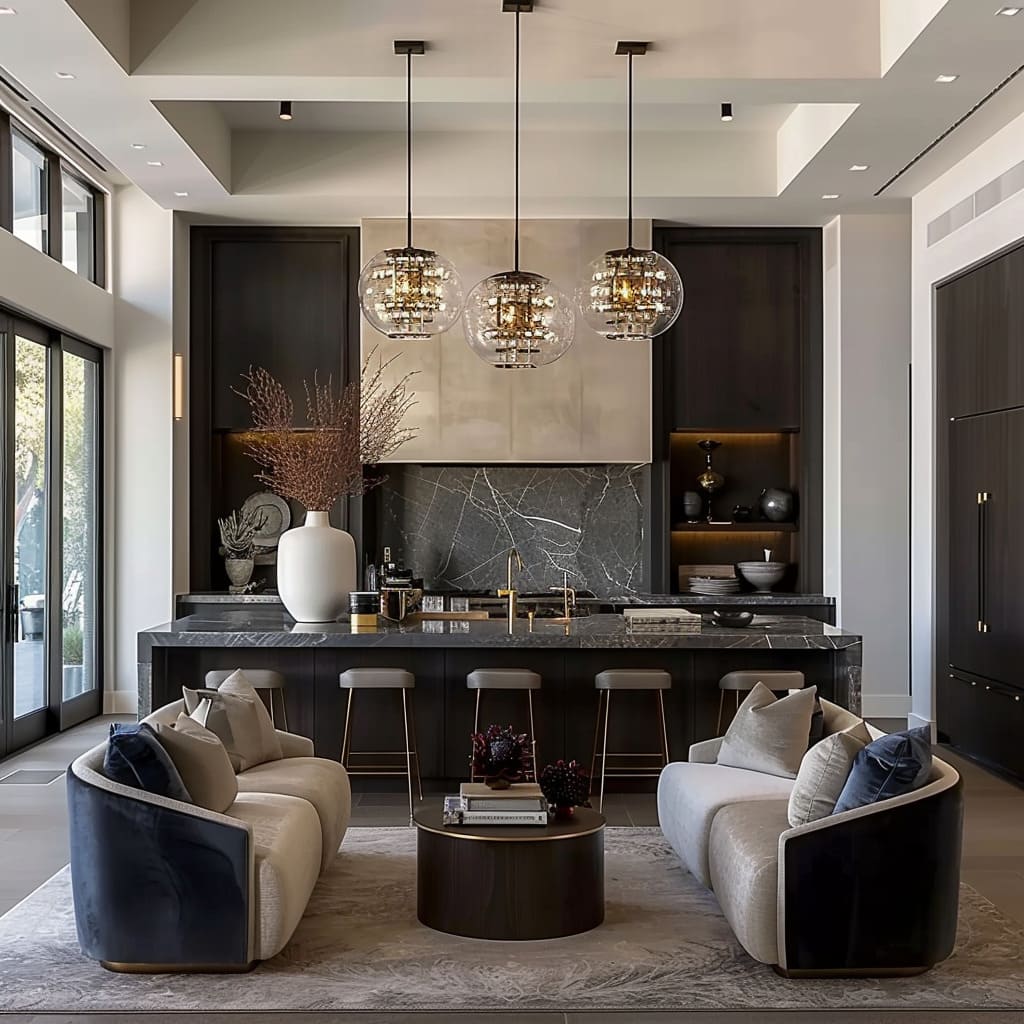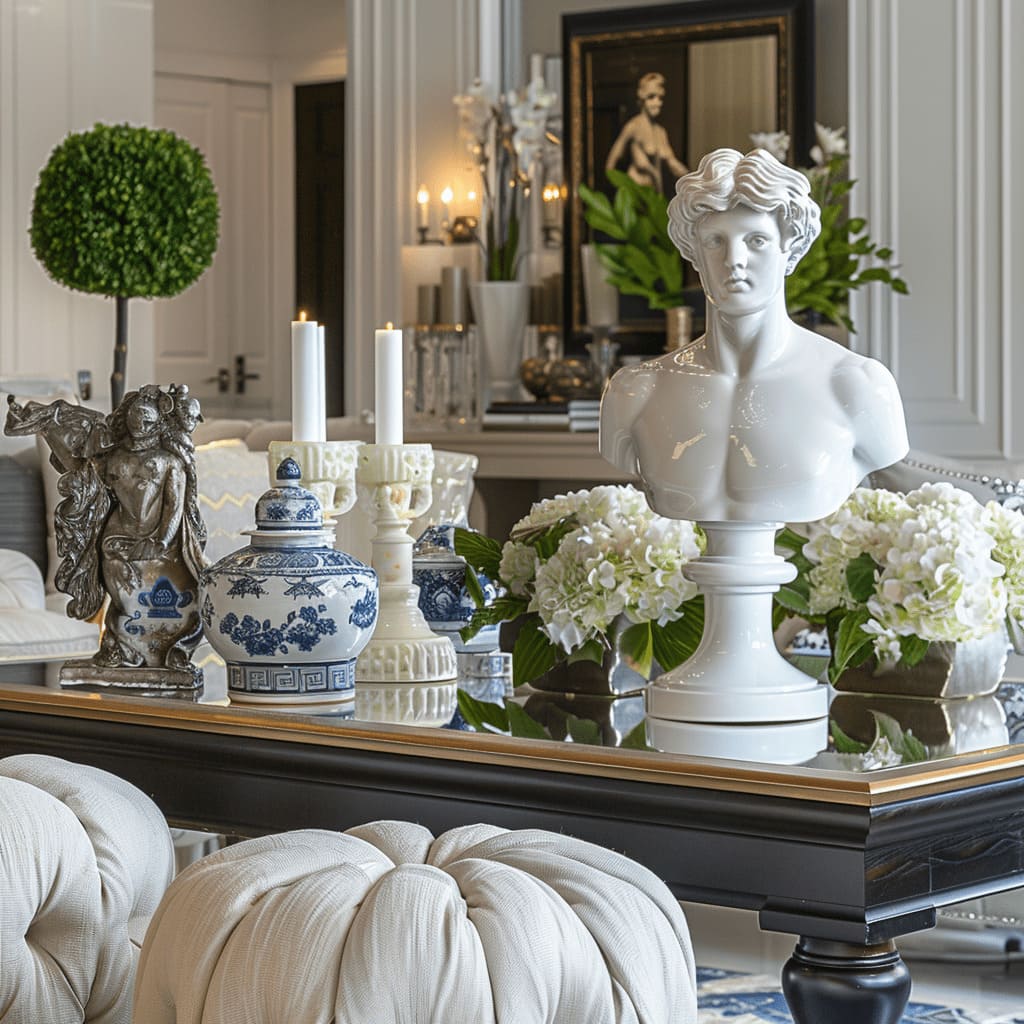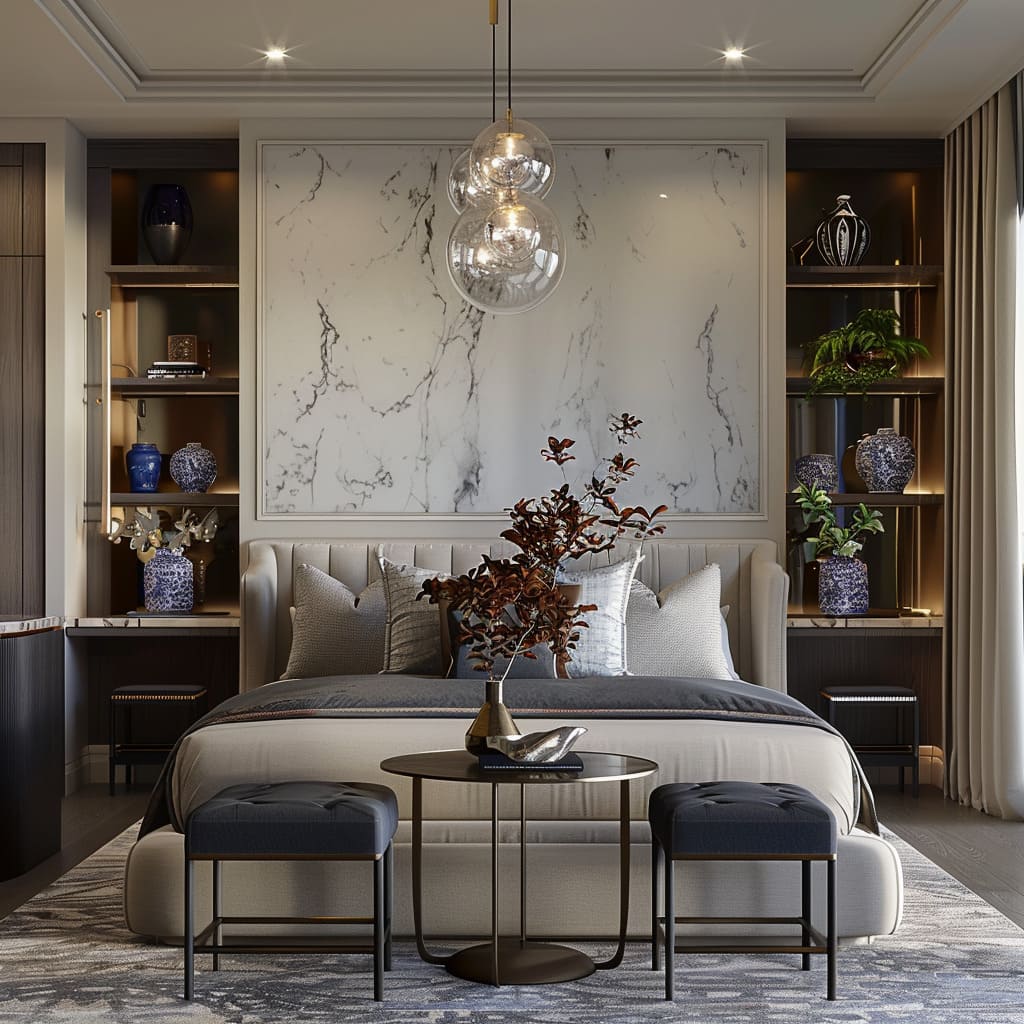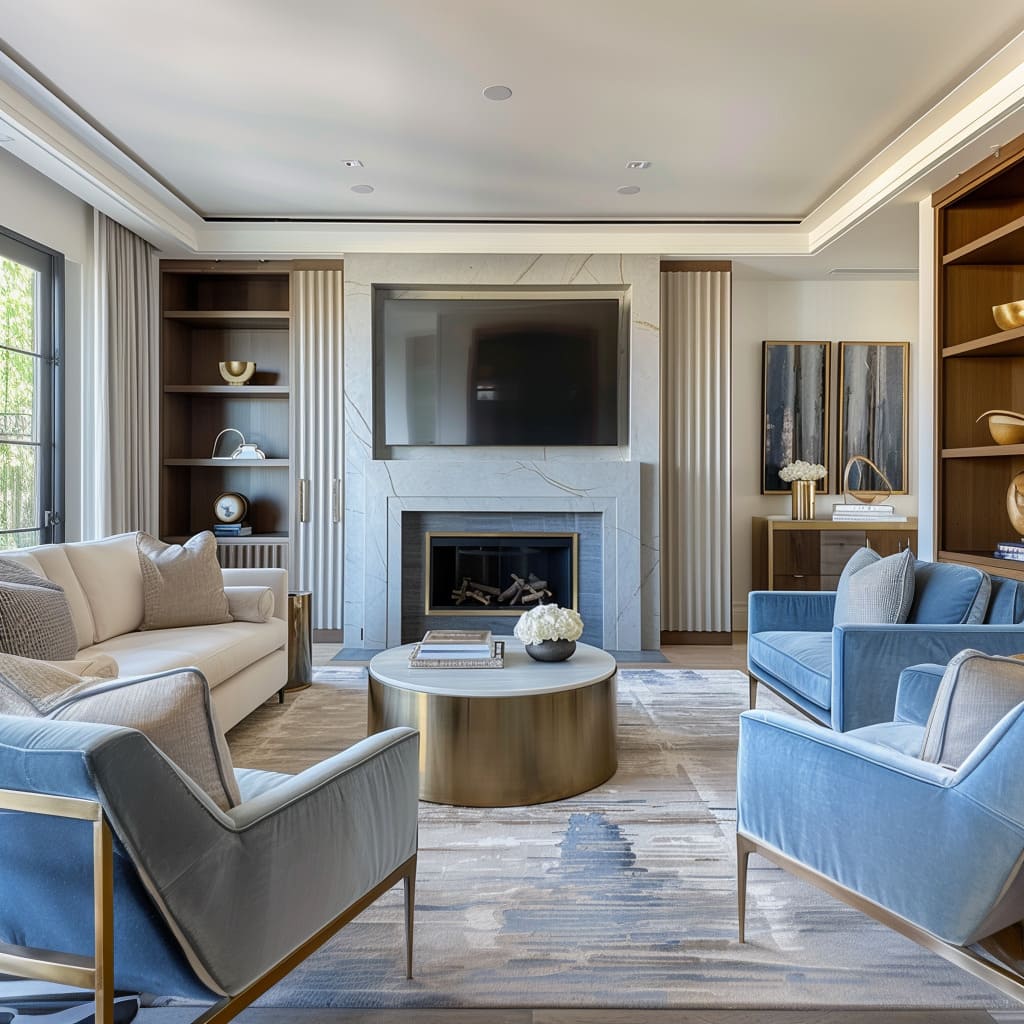In interior design, the thoughtful use of contrasting materials can transform a space, adding both visual appeal and tactile interest. Contrasting materials are not merely a stylistic choice but an effective tool that designers use to create a dynamic and engaging environment.
By blending different textures, colors, and finishes, one can craft interiors that are rich in character and warmth. This article explores the multifaceted appeal of using contrasting materials in various spaces, examining how they contribute to a room’s overall ambiance, functionality, and aesthetic.
We will delve into the psychological impact of these choices, the specific material combinations that work best, and how to implement these strategies effectively in any interior setting
Understanding Contrasting Materials in Interior Design
Definition and Significance
Contrasting materials in interior design refer to the use of different textures, colors, and finishes within a single space to create a more layered and nuanced environment. This practice involves pairing elements that differ significantly in feel and appearance—such as smooth marble with rough wood, or sleek metal with soft fabric.
The intent is to highlight these differences, creating a dialogue between the materials that adds depth and dimension to the space. The significance of this approach lies in its ability to elevate an interior from the ordinary to the extraordinary. By deliberately choosing materials that contrast yet complement each other, designers can craft spaces that are visually striking and emotionally engaging. The interplay of light and dark, rough and smooth, or shiny and matte surfaces can draw the eye and invite touch, creating a more immersive experience for the occupants
Psychological Impact of Contrasting Materials
The use of contrasting materials in interior spaces goes beyond aesthetic appeal; it also impacts the psychological state of those who interact with the space. For instance, a combination of warm wood and cool stone can evoke feelings of comfort and tranquility, while metal paired with soft textiles might suggest modernity and innovation. Different materials can trigger different emotional responses: a plush, velvet sofa against a backdrop of exposed brick can feel both luxurious and grounded, providing a sense of comfort while maintaining a modern edge.
Understanding these psychological effects allows designers to manipulate space in ways that enhance the desired mood and atmosphere. The choice of materials can influence how a space feels—whether cozy and intimate, or open and airy. The strategic use of contrasts can help balance these effects, ensuring that a room feels neither too stark nor overly busy
Exploring Different Material Combinations
Wood and Stone
One of the most classic combinations in interior design is wood and stone. This pairing brings together the organic warmth of wood with the cool, solid presence of stone, creating a harmonious balance that feels both natural and sophisticated. Wood, with its rich grains and warm hues, introduces a tactile softness to spaces, while stone, with its solid mass and natural veining, adds an element of strength and durability
In kitchens, the combination of dark wood cabinetry with a light stone countertop can create a striking visual contrast that is both modern and timeless. The use of these materials together not only adds visual interest but also enhances the functional qualities of the space. Stone is often used in areas that require durability and resistance to heat and moisture, while wood provides a warmer, more inviting surface that is pleasant to the touch
Metal and Fabric
Metal and fabric make for an intriguing combination in interior design, blending hard and soft textures to create a balanced and cohesive look. Metal elements, such as brushed steel or matte black iron, introduce a sleek and modern edge to a space, while fabrics like velvet, linen, or wool add softness and comfort. This combination is particularly effective in living areas and dining rooms, where the interplay between hard metal frames and plush upholstered seats creates a sophisticated yet inviting atmosphere.
Metal and fabric can also be used in lighting and accessories to further enhance the contrast. For example, a chandelier with a metal frame and fabric shades can provide both a functional light source and a decorative statement. The juxtaposition of metal and fabric can help to soften the harshness of industrial design while adding a touch of elegance and comfort
Glass and Wood
Glass and wood are another popular pairing that brings together the transparency and lightness of glass with the solidity and warmth of wood. This combination is often seen in contemporary and minimalist designs, where the use of glass helps to open up spaces and allow natural light to penetrate, while wood adds a grounding element that provides a sense of warmth and comfort.
Glass can be used in various forms, such as tabletops, shelving, or doors, while wood can be incorporated through cabinetry, flooring, or furniture. Together, these materials create a sense of balance and harmony, with the glass providing a light and airy feel and the wood offering a more substantial, tactile contrast
Marble and Matte Finishes
The contrast between marble and matte finishes offers a unique opportunity to combine luxury with subtlety in interior design. Marble, with its natural veining and polished surface, exudes elegance and sophistication, while matte finishes—whether in paint, cabinetry, or fixtures—introduce a more understated, contemporary feel. This combination works particularly well in kitchens and bathrooms, where the smooth, reflective qualities of marble can be balanced with the softer, more muted appearance of matte materials.
For instance, a kitchen with a marble island and matte black cabinetry can feel both opulent and grounded, striking the perfect balance between luxury and modernity
How does the strategic placement of wood and stone in a kitchen affect the overall functionality and visual flow of the space, particularly in terms of optimizing natural light and creating focal points?
The strategic placement of wood and stone in a kitchen significantly impacts both the functionality and visual flow, particularly in how these materials interact with natural light and create focal points.
When designing a kitchen, wood and stone are often used together to balance warmth and durability, providing both aesthetic appeal and practical surfaces for everyday use. The placement of these materials can optimize natural light by reflecting it in a way that enhances the space’s brightness and openness. For instance, light stone countertops or backsplashes can reflect natural light entering through windows, amplifying the brightness and making the kitchen feel more spacious.
In contrast, dark wood cabinetry can ground the space, offering a rich, warm contrast that adds depth without overpowering the light-enhancing elements.
Creating focal points in the kitchen is another critical aspect of using wood and stone strategically. A stone island with a waterfall edge can serve as a striking centerpiece, drawing the eye immediately upon entering the room. This not only emphasizes the luxurious quality of the stone but also provides a functional workspace central to the kitchen’s layout.
Meanwhile, wooden elements—such as open shelving or cabinetry—can frame this stone focal point, guiding the visual flow and subtly directing movement throughout the kitchen.
Moreover, the placement of wood and stone in different areas of the kitchen can delineate zones, enhancing functionality. For example, using stone in high-traffic areas or surfaces exposed to moisture and heat (like countertops and backsplashes) takes advantage of its durability and resistance.
In contrast, wood might be used in cabinetry or dining areas to introduce a softer, more inviting element. The interplay between these materials not only creates a visually dynamic space but also ensures that the kitchen is both practical for cooking and comfortable for socializing.
In summary, the strategic placement of wood and stone in a kitchen enhances functionality by optimizing natural light and creating visually appealing focal points. By carefully considering how these materials are positioned, designers can craft a kitchen that is both efficient in use and striking in appearance.
When combining metal and fabric in living areas or dining rooms, what are the specific design considerations or techniques used to ensure that the space remains both inviting and visually cohesive without leaning too heavily towards an industrial or overly soft aesthetic?
When combining metal and fabric in living areas or dining rooms, several specific design considerations and techniques are employed to maintain a balance between the two contrasting elements, ensuring the space remains inviting and visually cohesive without becoming too industrial or overly soft. The goal is to create a harmonious interplay between the hard, sleek surfaces of metal and the soft, textured qualities of fabric, blending them seamlessly within the room’s overall design.
Proportional Balance Between Metal and Fabric:
A key consideration in combining metal and fabric is achieving a proportional balance between these materials. Too much metal can make a space feel cold and industrial, while an excess of fabric might create an overly soft or even cluttered appearance. Designers often use metal elements selectively, focusing on key pieces like a coffee table frame, light fixtures, or chair legs, while allowing fabric to dominate larger surfaces such as sofas, chairs, or drapery.
For instance, pairing a metal-framed glass coffee table with plush, upholstered seating can create a sophisticated contrast, where the metal adds structure and a modern edge, and the fabric introduces warmth and comfort.
Choosing Complementary Colors and Finishes:
To ensure cohesion, it’s crucial to choose complementary colors and finishes for both metal and fabric elements. The finish of the metal—whether it’s brushed, matte, or polished—should align with the overall color scheme of the room. For example, a brushed brass light fixture can add warmth and coordinate well with earth-toned or neutral fabrics, enhancing a welcoming atmosphere.
Similarly, matte black metal can provide a contemporary contrast against soft, lighter-colored fabrics, preventing the space from feeling overly stark or harsh.
Introducing Soft Curves and Rounded Edges:
When incorporating metal, using pieces with soft curves or rounded edges can prevent the space from feeling too rigid or industrial. Curved metal legs on a chair or a circular metal-framed coffee table can add a gentle, organic quality that balances the hardness of the material. Pairing these with softer, rounded cushions or throws can further soften the overall aesthetic.
This technique ensures the room feels approachable and comfortable, avoiding the stark, hard lines that are often associated with industrial styles.
Layering Textures to Enhance Visual Interest:
Layering different textures is another technique to harmonize metal and fabric within a space. Combining a variety of fabrics—such as velvet, linen, or wool—with sleek metal accents creates a rich, tactile experience. For instance, a living room might feature a linen sofa complemented by a metal and wood coffee table, with additional texture added through a wool rug or silk throw pillows.
This layering not only adds depth and visual interest but also ensures the space feels inviting and well-curated.
Strategic Use of Accessories and Accents:
Accessories and smaller accents are effective ways to blend metal and fabric without overwhelming the design. Metal elements like decorative bowls, picture frames, or light fixtures can introduce just the right amount of shine and contrast. At the same time, fabric accessories—such as pillows, curtains, or upholstered stools—can add softness and comfort.
Mixing these smaller elements thoughtfully throughout the room ensures that both materials are represented, creating a cohesive and balanced look.
Creating Defined Zones with Material Combinations:
Another technique is using metal and fabric to define different zones within an open-plan living or dining area. For example, a dining area might feature metal-framed dining chairs with fabric seats, distinguishing it from a nearby living area dominated by a large, upholstered sofa with metal side tables. This strategic use of contrasting materials helps to subtly differentiate areas within a shared space while maintaining a unified overall aesthetic.
In conclusion, the successful combination of metal and fabric in living areas or dining rooms involves careful consideration of proportion, color, texture, and form. By thoughtfully selecting and placing these materials, designers can create a space that feels both modern and comfortable, striking the perfect balance between sleek, industrial elements and inviting, cozy touches. This approach ensures that the room remains visually cohesive and engaging without leaning too heavily towards either extreme.
In contemporary and minimalist designs that feature glass and wood, what role does the choice of wood finish (such as dark or light stains) and glass type (clear, frosted, or tinted) play in influencing the perception of space size and light distribution within the room?
In contemporary and minimalist designs that utilize a combination of glass and wood, the choice of wood finish and glass type plays a significant role in shaping the perception of space size and influencing light distribution within a room. These design choices are crucial for creating a desired atmosphere, enhancing the room’s visual appeal, and achieving a balanced interplay between openness and warmth.
Influence of Wood Finish on Space Perception and Atmosphere:
The choice of wood finish—whether dark or light—can dramatically affect how a space is perceived in terms of size and ambiance. Light wood finishes, such as oak, pine, or maple with natural or pale stains, tend to reflect more light, creating a sense of openness and airiness. These finishes are ideal in minimalist and contemporary designs where the goal is to enhance the feeling of space and prevent the room from feeling confined or heavy.
The light color of the wood helps to bounce light around the room, which is particularly beneficial in smaller spaces or areas with limited natural light, as it can make the room appear larger and more inviting.
Conversely, dark wood finishes like walnut, mahogany, or wenge, which feature deeper, richer stains, add a sense of depth and luxury but can also visually reduce the perceived size of a room. Dark wood tends to absorb more light, which can make a space feel cozier and more intimate, but if overused, it might also make the room feel smaller and more enclosed. Therefore, in contemporary minimalist designs, dark wood is often used strategically—perhaps as an accent or in combination with lighter elements—to create visual interest and avoid overpowering the space.
Role of Glass Type in Light Distribution and Spatial Perception:
The type of glass used—whether clear, frosted, or tinted—also significantly impacts the distribution of light and the perception of space. Clear glass is the most transparent and allows the maximum amount of light to pass through, helping to maintain an unobstructed view and creating a sense of continuity within the room. This can make a space feel more open and expansive, as there are no visual barriers interrupting the flow of light or sightlines.
Clear glass is particularly effective in minimalist designs where the emphasis is on simplicity and open space, often used in windows, doors, partitions, or shelving to enhance the natural light and create a seamless connection between different areas.
Frosted glass, on the other hand, diffuses light more softly, reducing glare and providing a sense of privacy while still allowing light to filter through. This type of glass is beneficial in spaces where a softer, more diffused light is desired, such as in bathrooms or areas that require privacy without sacrificing light. Frosted glass can make a room feel more tranquil and subdued, as it softens harsh light and reduces contrast, creating a more uniform lighting effect.
Tinted glass adds another layer of complexity by subtly altering the color of the light that passes through it. Depending on the tint color, this can create a warm or cool ambiance, influencing the mood of the room. Tinted glass can also reduce the amount of light entering a space, which might be desirable in rooms with excessive sunlight or where a more subdued lighting effect is preferred.
However, excessive use of tinted glass can make a room feel darker and smaller, so it is often used in combination with other types of glass or lighter materials to maintain balance.
Combining Wood Finishes and Glass Types for Optimal Effect:
In contemporary and minimalist interiors, the strategic combination of wood finishes and glass types can be used to manipulate both space and light to achieve a specific design intent. For instance, pairing light wood finishes with clear glass can maximize light reflection and distribution, creating a bright, airy feel that enhances the sense of spaciousness. This combination is particularly effective in smaller spaces or open-plan areas where maintaining an open and uncluttered feel is essential.
Alternatively, using dark wood with frosted or tinted glass can create a more intimate and cozy atmosphere, ideal for spaces like bedrooms or study areas where a sense of seclusion and comfort is desired. The frosted glass will diffuse light gently, complementing the rich tones of the dark wood and creating a harmonious balance that adds depth and warmth to the room.
In conclusion, the choice of wood finish and glass type in contemporary and minimalist designs plays a pivotal role in shaping both the visual and functional characteristics of a space. By carefully selecting these materials, designers can manipulate light, create focal points, and influence the perceived size and atmosphere of a room, crafting spaces that are both beautiful and practical.
Techniques for Incorporating Contrasting Materials
Layering Textures and Colors
Layering different textures and colors is a fundamental technique in incorporating contrasting materials into a space. This approach involves combining multiple elements—such as soft textiles with hard surfaces, or bright colors with muted tones—to create a rich and layered visual experience. In practice, this could mean pairing a plush velvet sofa with a rough-hewn wooden coffee table, or combining a smooth marble countertop with a textured backsplash.
The key to successful layering is to strike a balance between contrast and cohesion, ensuring that the different elements work together to create a unified look. By carefully selecting materials that complement each other while offering a distinct contrast, designers can create spaces that are visually dynamic and engaging.
Focal Points and Accents
Using contrasting materials to create focal points and accents is another effective strategy in interior design. Focal points are elements that draw the eye and serve as the centerpiece of a room, while accents are smaller details that add interest and depth. Contrasting materials can be used to create both, whether it’s a bold marble fireplace set against a backdrop of matte black walls, or a vibrant metal sculpture on a wooden console table.
The use of contrasting materials in these areas helps to highlight the unique qualities of each material, drawing attention to their texture, color, and form. This approach can also help to create a sense of balance and harmony in a space, as the eye is naturally drawn to the areas of contrast, creating a visual rhythm that enhances the overall design
Balance and Harmony
Achieving balance and harmony when using contrasting materials is crucial to the success of any interior design project. This involves carefully considering the proportions and relationships between different elements, ensuring that no single material dominates the space. For example, a room with a heavy use of dark wood may feel overwhelming if not balanced with lighter elements, such as a light-colored rug or glass accessories.
Similarly, a space dominated by hard materials, like metal and stone, can feel cold and unwelcoming if not softened with fabrics or warm wood tones. By carefully balancing contrasting materials, designers can create spaces that feel cohesive and harmonious, with each element contributing to the overall aesthetic and functionality of the space.
Case Studies and Real-World Applications
Modern Kitchen Design
A modern kitchen design that incorporates contrasting materials can create a space that is both functional and visually stunning. In this example, dark wood cabinetry is paired with a light marble countertop, creating a striking contrast that adds depth and interest to the space. The use of metal accents, such as stainless steel appliances and brushed nickel fixtures, adds a sleek, modern touch, while the natural veining of the marble brings in an element of organic beauty.
The combination of these materials not only enhances the aesthetic appeal of the kitchen but also provides a durable and practical workspace that is ideal for cooking and entertaining.
Luxurious Living Room Setup
In a luxurious living room setup, the use of contrasting materials can create a space that is both elegant and comfortable. For instance, a large sectional sofa upholstered in a soft, neutral fabric can be paired with a dark wood coffee table and a marble fireplace surround. The combination of these materials adds a sense of depth and richness to the space, while also creating a balance between softness and strength.
The use of contrasting materials in the lighting, such as a metal chandelier with fabric shades, can further enhance the overall aesthetic, adding both warmth and sophistication to the room
Contemporary Bedroom Design
A contemporary bedroom design that incorporates contrasting materials can create a space that is both calming and visually engaging. In this example, a plush upholstered bed is paired with a wooden accent wall and metal bedside tables. The combination of these materials adds a sense of warmth and texture to the room, while also creating a balance between modernity and comfort.
The use of contrasting materials in the accessories, such as a glass vase with a metal base or a ceramic lamp with a fabric shade, can further enhance the overall aesthetic, adding both interest and depth to the space
Benefits and Challenges of Using Contrasting Materials
Benefits
Using contrasting materials in interior design offers a range of benefits, from enhancing the visual appeal of a space to creating a more engaging and dynamic environment. The use of contrasting materials can help to highlight the unique qualities of each element, drawing attention to their texture, color, and form. This can create a more immersive experience for the occupants, as the eye is naturally drawn to the areas of contrast, creating a visual rhythm that enhances the overall design.
In addition, the use of contrasting materials can help to create a sense of balance and harmony in a space, ensuring that no single material dominates the room.
Challenges
While the use of contrasting materials in interior design offers many benefits, it also presents certain challenges. One of the main challenges is achieving a balance between contrast and cohesion, ensuring that the different materials work together to create a unified look. This requires careful consideration of the proportions and relationships between different elements, as well as a keen eye for color, texture, and form.
Another challenge is ensuring that the use of contrasting materials does not overwhelm the space, creating a chaotic or disjointed look. This requires a careful balance between bold and subtle elements, as well as a thoughtful approach to placement and composition
Conclusion. Contrasting materials play a pivotal role in creating dynamic and engaging interior spaces.
By carefully selecting and combining different textures, colors, and finishes, designers can craft interiors that are visually striking and emotionally engaging. Whether it’s a modern kitchen with a blend of wood and marble, a luxurious living room with metal and fabric accents, or a contemporary bedroom with contrasting textures, the use of contrasting materials can elevate a space from the ordinary to the extraordinary.
As with any design choice, it is important to carefully consider the balance and harmony of these elements to ensure a cohesive and unified look. With the right approach, contrasting materials can add depth, interest, and sophistication to any interior, creating spaces that are both beautiful and functional.










































